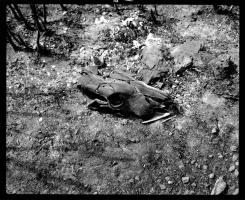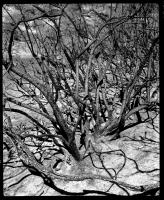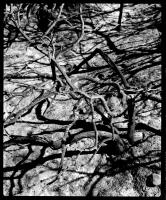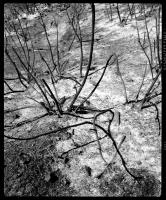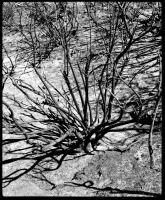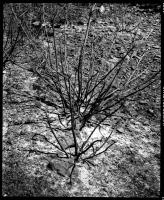«Ο Γιάννης Σταθάτος, στη σειρά άκεα (1996) αντιδιαστέλλει τη γνώση που διατυπωνόταν σε αρχαία φιλοσοφικά πονήματα που έφεραν συχνά τον τίτλο "Περί Φύσεως" με τη σύγχρονη πραγματικότητα του ελληνικού τοπίου, εξετάζοντας τον καθαρτήριο ρόλο του φυσικού φαινομένου της φωτιάς σε σχέση με τις καταστροφικές πυρκαγιές που απογυμνώνουν τη σύγχρονη Ελλάδα.»
Ηρακλής Παπαϊωάννου, Η φωτογραφία του ελληνικού τοπίου: μεταξύ μύθου και πραγματικότητας, Άγρα, Αθήνα 2014
It has been argued that all western thought can be traced back to the presocratic philosopher Heraclitus of Ephesus. Of Heraclitus’ monumental work About Nature, exactly 1,243 words survive – a total, by the latest count, of 114 fragments. Three of these fragments consist of a single word, and of these, the shortest is just four letters long: ákea. This rare ancient Greek term can mean “cures”, but also has the sense of “atonements” or “sacrifices”. Its precise context is of course irrecoverable now, but it seems in harmony with the basic tenets of Heraclitean thought as expressed through some of the other surviving fragments, and in particular the idea of purification through a real or metaphorical fire. For Heraclitus, fire was one of the three basic elements of the universe as well as an agent of cyclical regeneration; as he reminds us in another fragment, fire when it comes will judge and condemn all things.
I have been working with and around Heraclitean texts for some time now, starting with Three Heraclitean Elements (1991). ákea: atonements is the development of a smaller work originally made for the Photography Centre of Athens in 1994, and was first shown in its final form in the monastic dormitory of the 14th-century Estonian castle of Kuressaare in 1995. The images are of burned and calcinated vegetation photographed on a Greek island within a few hours of a brush fire, while the ground was still hot and covered with a drift of fine grey ash. Austere representations of a fired landscape or tabula rasa from the southernmost edge of Europe, their import and context is universal.
John Stathatos (1996)
Περιγραφή
Έξη μοναδικές εκτυπώσεις αργύρου επί αλουμινίου, 165 x 145 εκ
The images are also available in 33x24 cm prints in a limited edition of five.
Ιστορικό εκθέσεων
• 1995 Kuressaare Castle, Saaremaa Biennial, Εσθονία
• 1996 “Μύθος και Τοπίο”, Ευρωπαϊκό Πολιτιστικό Κέντρο Δελφών, Δελφοί
• 1996 Wigmore Fine Arts, Λονδίνο
Δημοσιεύσεις
• Fabrique d’Histoire, catalogue, Saaremaa, Εσθονία 1995
• akea: atonements, Wigmore Fine Arts, Λονδίνο 1996
• Myth and Landscape/ Μύθος και Τοπίο, Ευρωπαϊκό Πολιτιστικό Κέντρο Δελφών, Αθήνα 1996
• Camera International 42, Παρίσι, Καλοκαίρι 1996
Βιβλιογραφία:
• Clifford Myerson, “The Sense of Time Passing in Photography”, Art & Design 44, ΛΟνδίνο, Σεπτέμβριος 1995
• Thomas McEvilley, “The Pendulum Swings”, Art in America, (NY), Μάρτιος 1996
• Sotiris Kyriakou, “John Stathatos”, Galleries UK, Νοέμβριος 1996
